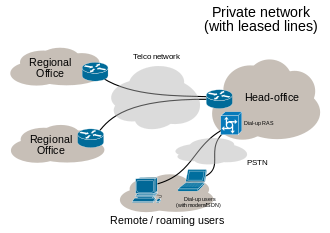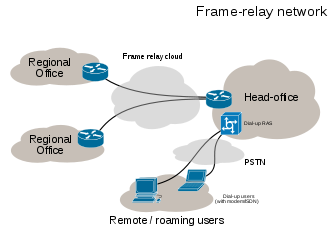Leased line
This article has multiple issues. Please help improve it or discuss these issues on the talk page. (Learn how and when to remove these template messages)
|
A leased line is a private
Unlike traditional telephone lines in the
The primary factors affecting the recurring lease fees are the distance between
An Internet leased line is a premium Internet connectivity product, normally delivered over fiber, which provides uncontended, symmetrical bandwidth with full-duplex traffic. It is also known as an Ethernet leased line, dedicated line, data circuit or private line.
History
Leased line services (or private line services) became digital in the 1970s with the conversion of the Bell backbone network from analog to digital circuits. This allowed AT&T to offer Dataphone Digital Services (later re-branded digital data services) that started the deployment of ISDN and T1 lines to customer premises to connect.[1]
Leased lines were used to connect mainframe computers with terminals and remote sites, via IBM's Systems Network Architecture (created in 1974) or DEC's DECnet (created in 1975).
With the extension of digital services in the 1980s, leased lines were used to connect customer premises to Frame Relay or ATM networks. Access data rates increased from the original T1 option with maximum transmission speed of 1.544 Mbit/s up to T3 circuits.
In the 1990s, with the advances of the Internet, leased lines were also used to connect customer premises to
Access data rates also evolved dramatically to speeds of up to 10 Gbit/s in the early 21st century with the
Applications


Leased lines are used to build up private networks, private telephone networks (by interconnecting
Here is a review of the leased-line applications in
Site to site data connectivity
Terminating a leased line with two routers can extend network capabilities across sites. Leased lines were first used in the 1970s by enterprise with proprietary protocols such as IBM
Site to site PBX connectivity
Terminating a leased line with two PBX allowed customers to by-pass PSTN for inter-site telephony. This allowed the customers to manage their own dial plan (and to use short extensions for internal telephone number) as well as to make significant savings if enough voice traffic was carried across the line (especially when the savings on the telephone bill exceeded the fixed cost of the leased line).
Site to network connectivity
As demand grew on data network telcos started to build more advanced networks using packet switching on top of their infrastructure. Thus, a number of telecommunication companies added ATM, Frame-relay or ISDN offerings to their services portfolio. Leased lines were used to connect the customer site to the telco network access point.
International private leased circuit
An international private leased circuit (IPLC) functions as a point-to-point private line. IPLCs are usually time-division multiplexing (TDM) circuits that utilize the same circuit amongst many customers. The nature of TDM requires the use of a CSU/DSU and a router. Usually the router will include the CSU/DSU.
Then came the Internet (in the mid-1990s) and since then the most common application for leased line is to connect a customer to its ISP point of presence. With the changes that the Internet brought in the networking world other technologies were developed to propose alternatives to frame-relay or ATM networks such as
Availability
In the United Kingdom
In the
As of March 2018, Leased Line services are most commonly available in the region of 100 Mbit/s to 1 Gbit/s. In large cities, for example, London, speeds of 10 Gbit/s are attainable.
In the United States
In the U.S., low-speed leased lines (56 kbit/s and below) are usually provided using analog modems. Higher-speed leased lines are usually presented using FT1 (Fractional T1): a T1 bearer circuit with 1 to 24, 56k or 64k timeslots. Customers typically manage their own network termination equipment, which include a Channel Service Unit and Data Service Unit (CSU/DSU).
In Hong Kong
In
Fibre circuits are slowly replacing the traditional circuits and are available at nearly any bandwidth.
In India
In
In Italy
In
For many purposes, leased lines are gradually being replaced by
Leased line alternatives
Leased lines are more expensive than alternative connectivity services including (
See also
References
- ^ Microsoft Encyclopedia of Networking, Second Edition. Microsoft Press. 2002.
